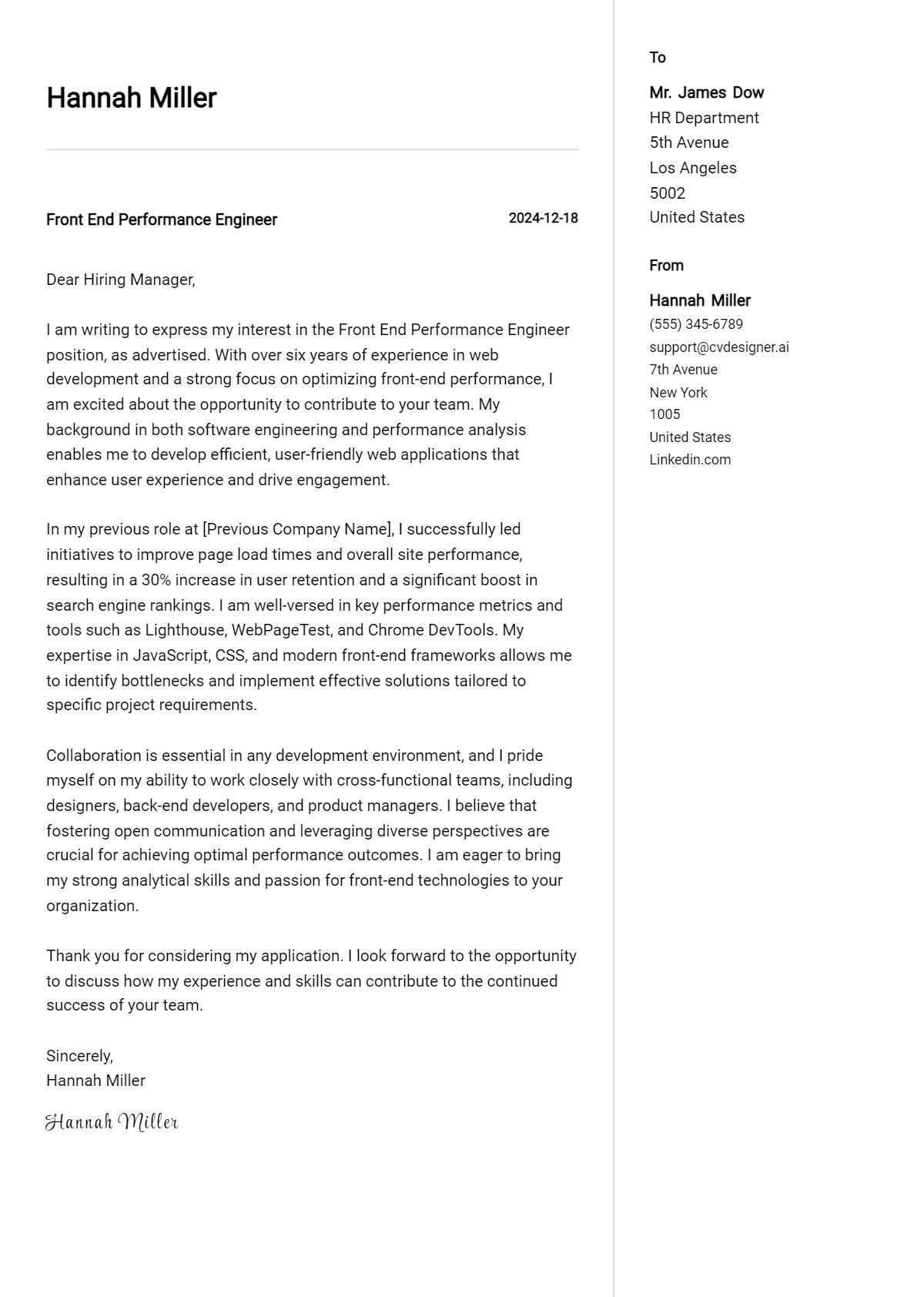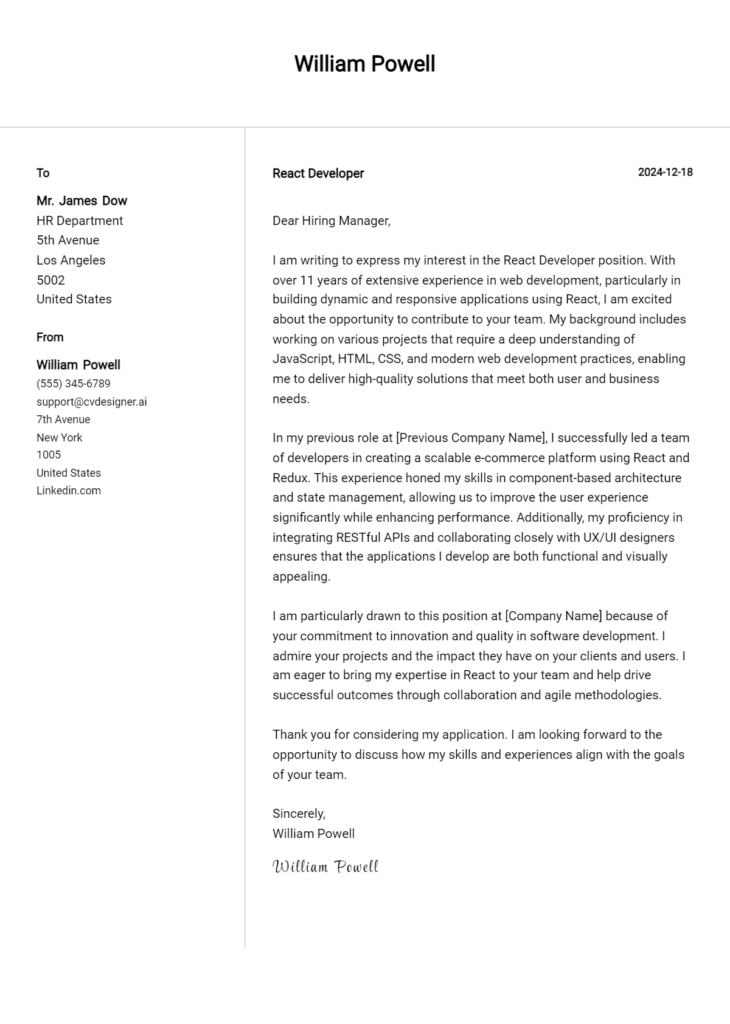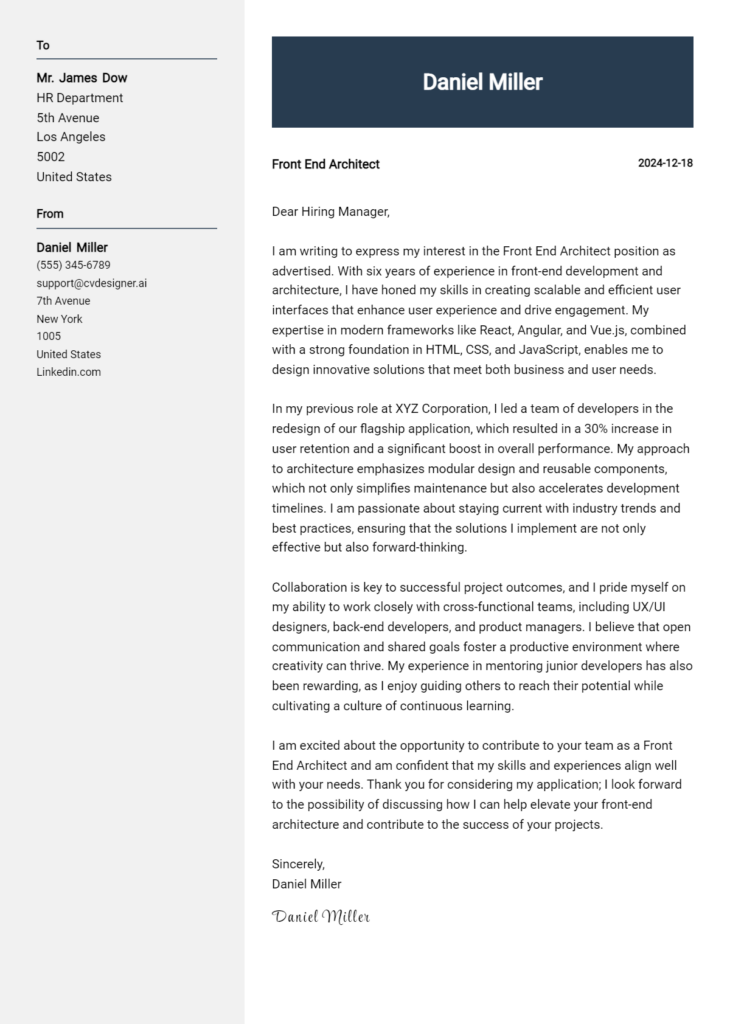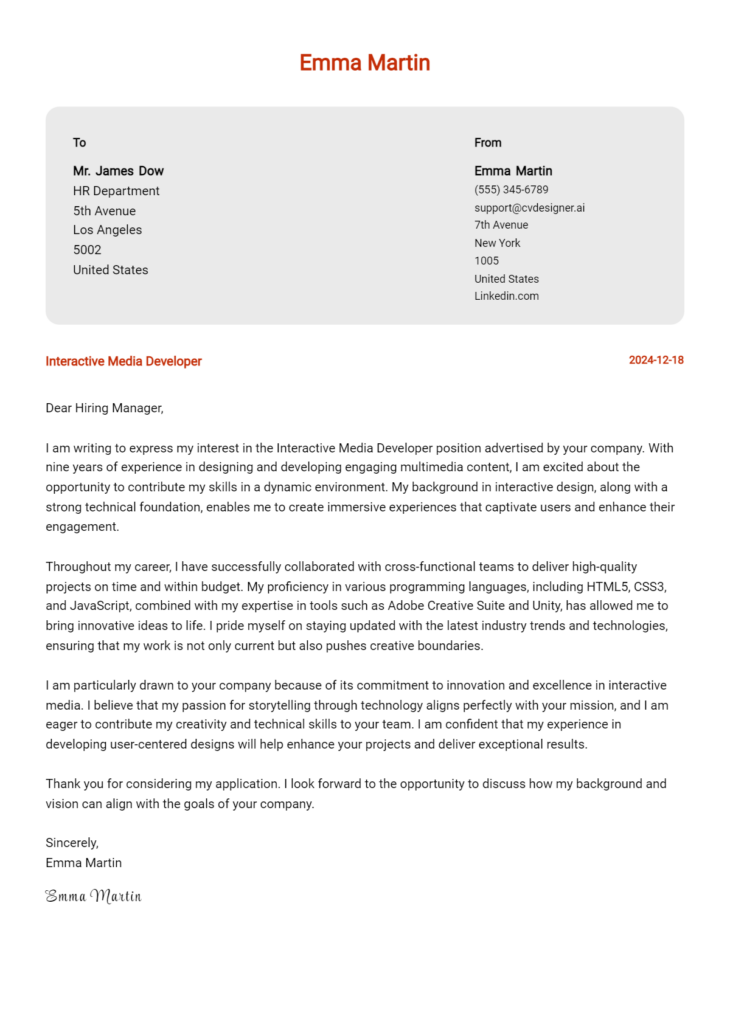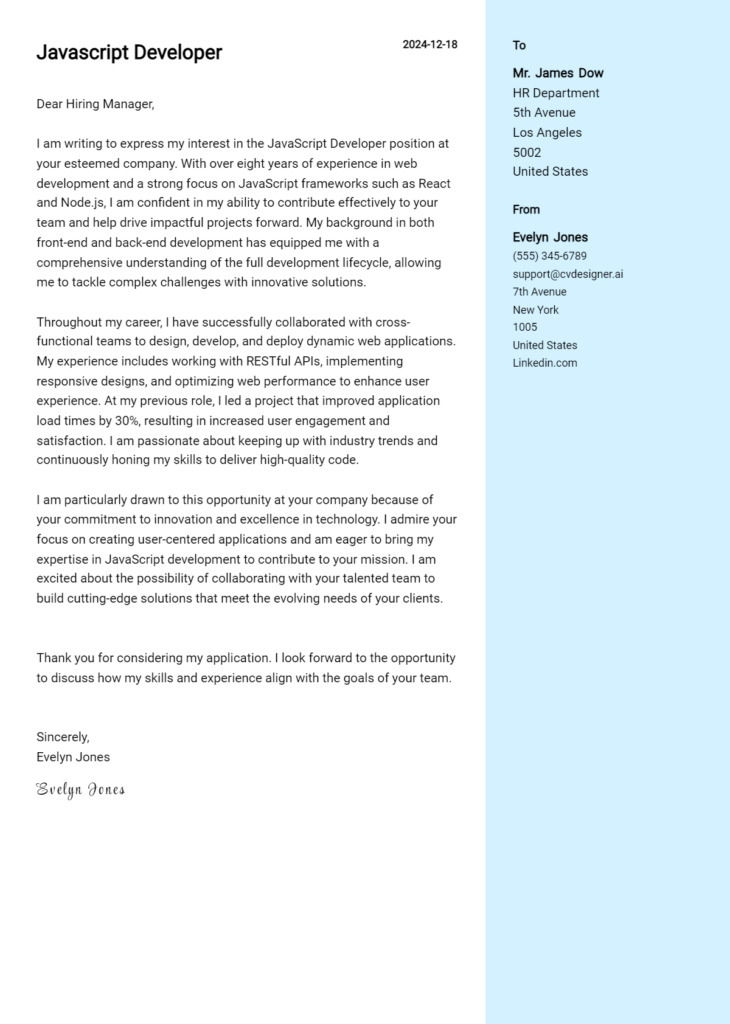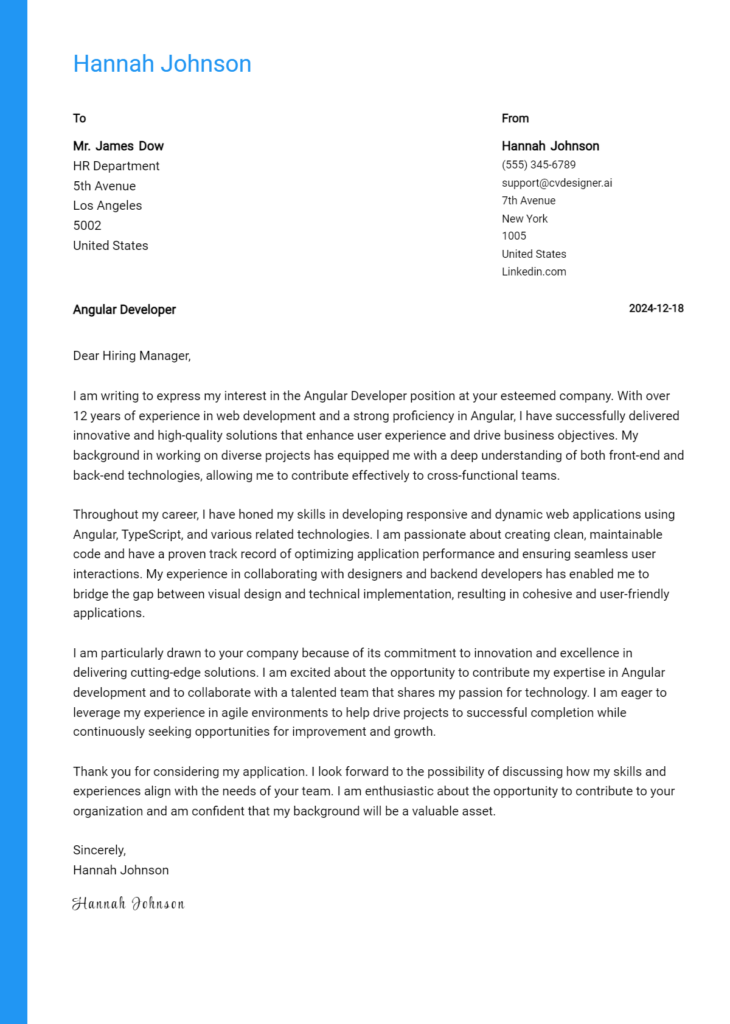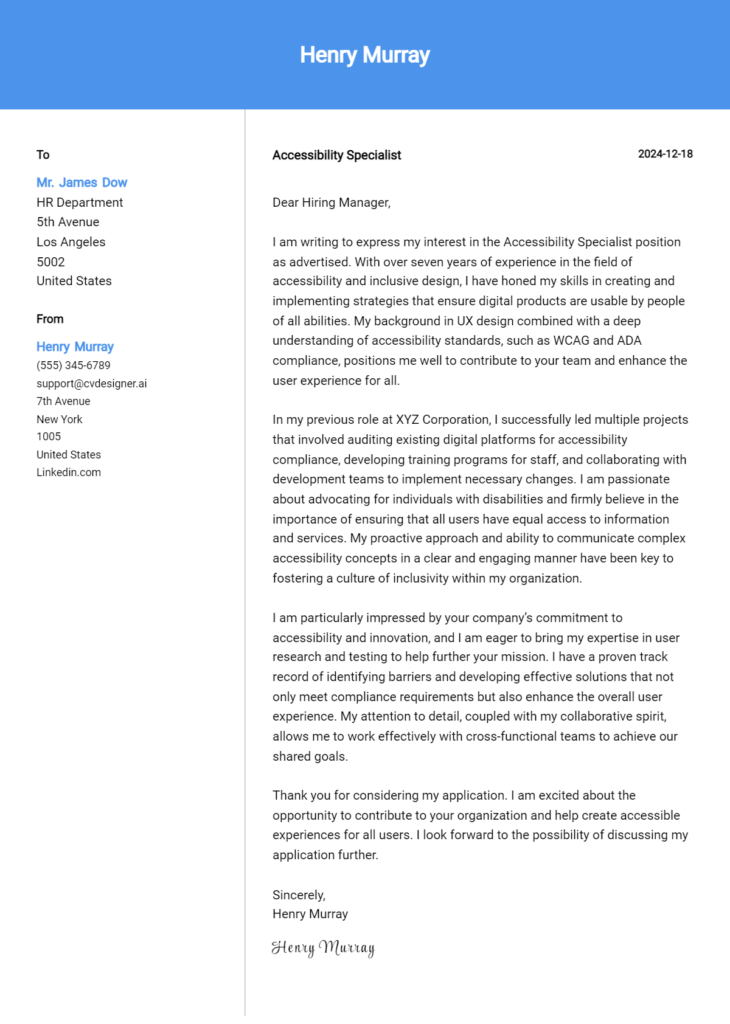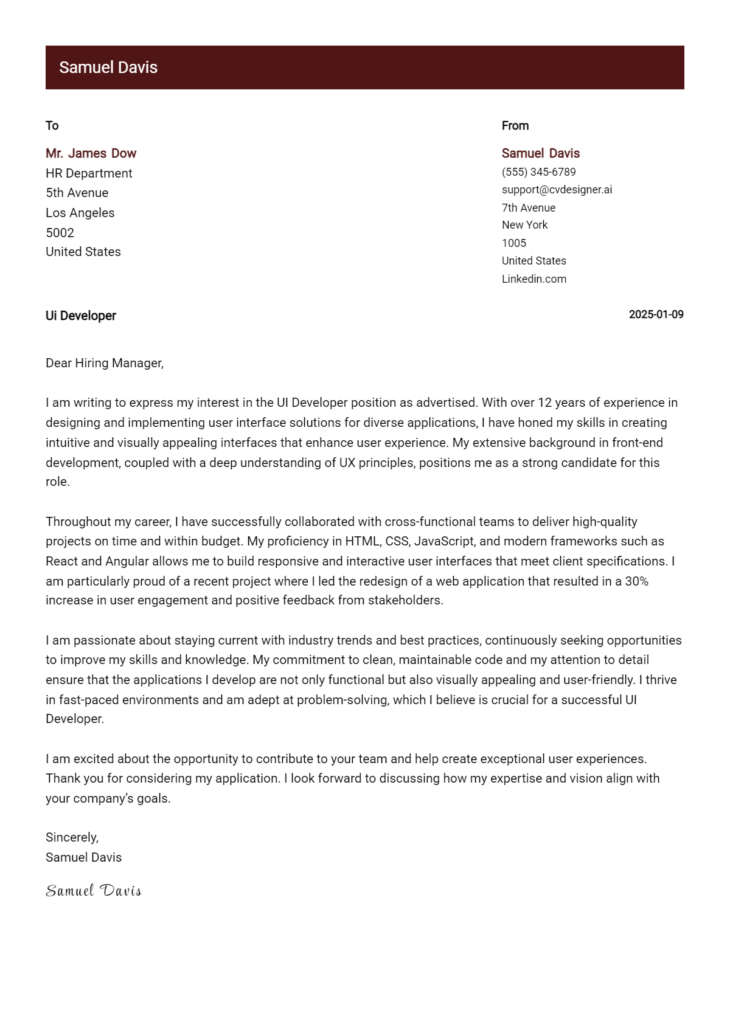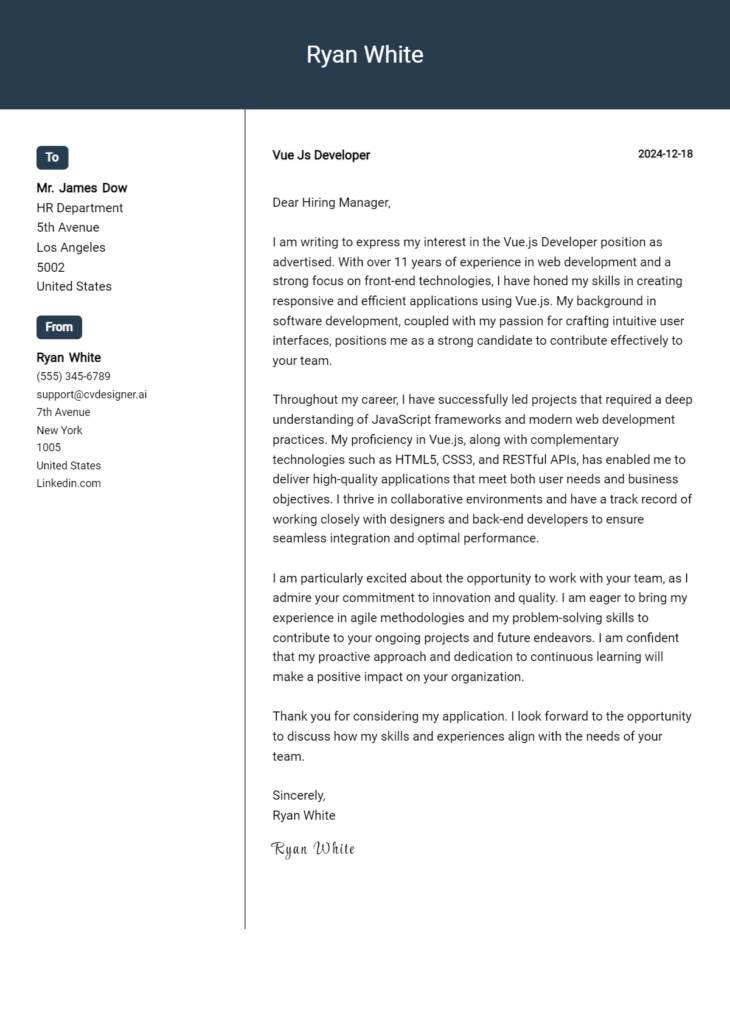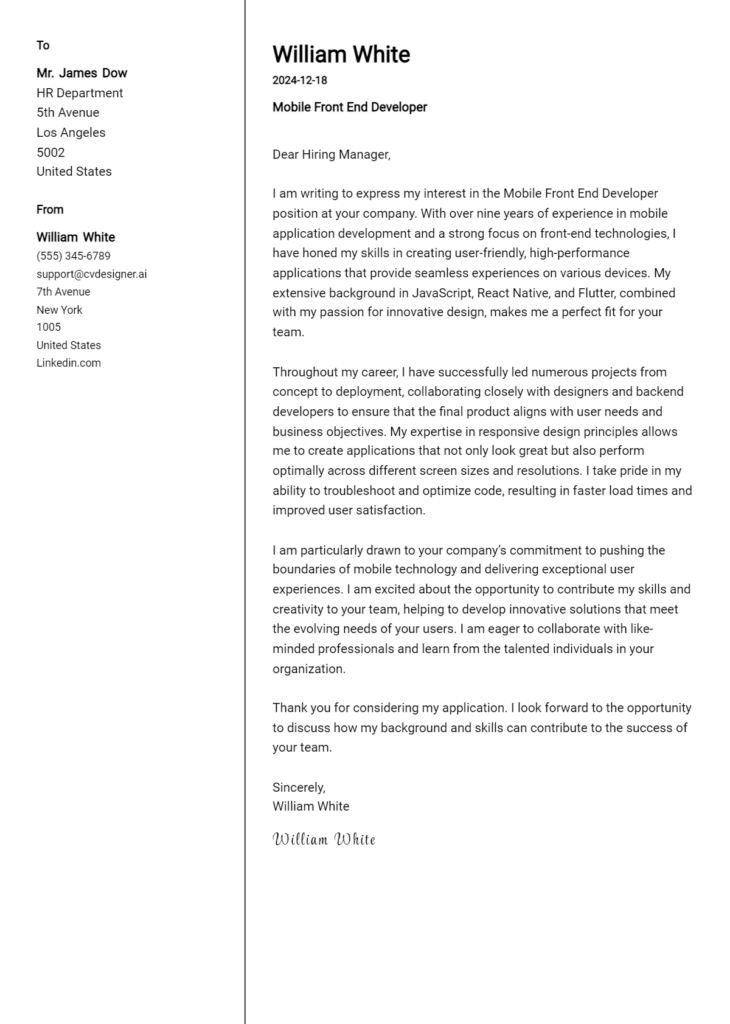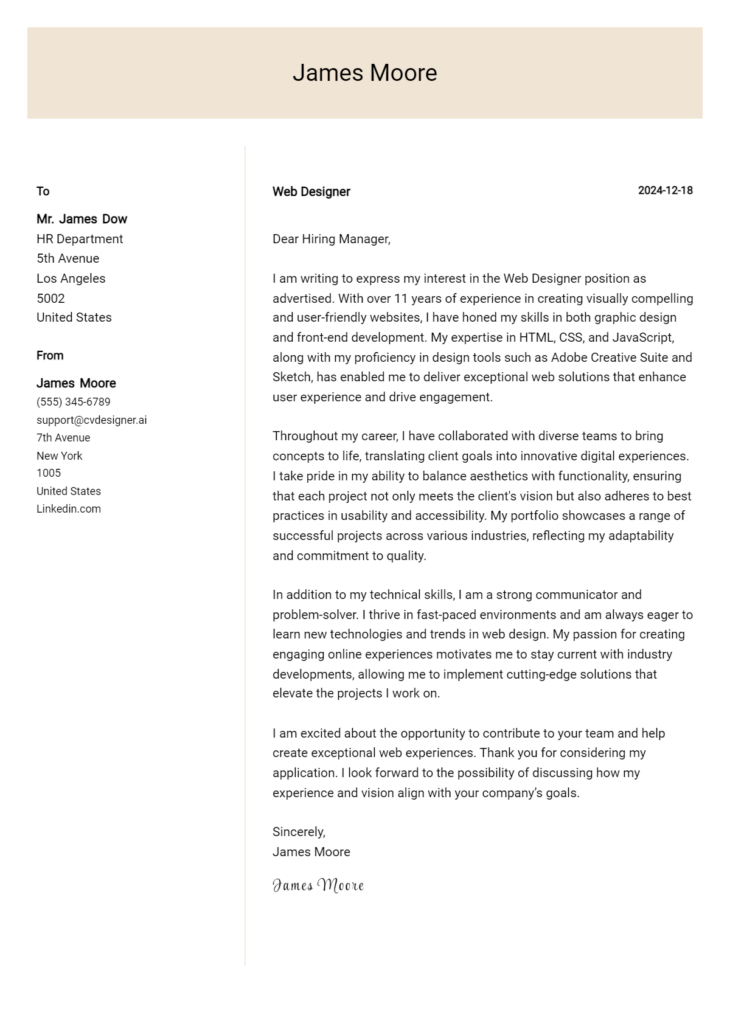Front End Performance Engineer Cover Letter Examples
Explore additional Front End Performance Engineer cover letter samples and guides and see what works for your level of experience or role.
How to Format a Front-End Performance Engineer Cover Letter?
Crafting an effective cover letter is essential for a Front-End Performance Engineer, as it serves as a gateway to showcase your technical expertise and problem-solving abilities. The way you format your cover letter can significantly influence how hiring managers perceive your qualifications, reflecting your attention to detail and understanding of user experience—the cornerstones of front-end development. A well-structured cover letter not only grabs the hiring manager's attention but also demonstrates your commitment to delivering high-performance web applications.
In this guide, we'll outline how to structure your cover letter, offering insights and examples tailored for Front-End Performance Engineers to help you create a compelling document.
We'll focus on the essential components of a professional cover letter, including:
- Cover Letter Header
- Cover Letter Greeting
- Cover Letter Introduction
- Cover Letter Body
- Cover Letter Closing
Each section plays a critical role in effectively communicating your qualifications and professionalism. Let's break down each part and explain how to make your Front-End Performance Engineer cover letter shine.
Importance of the Cover Letter Header for a Front-End Performance Engineer
The header of a cover letter is a crucial element that sets the tone for the entire document. It provides essential contact information, establishes professionalism, and makes it easy for employers to reach out to you. For a Front-End Performance Engineer, where clarity and attention to detail are key, your header should be impeccably formatted and include your name, address, phone number, email, the date, and the recipient's details (name, title, company, address). A well-structured header not only conveys your professionalism but also ensures that your application stands out in a competitive job market.
Strong Example
John Doe 123 Main Street City, State, ZIP (123) 456-7890 john.doe@email.com October 10, 2023 Jane Smith Hiring Manager Tech Innovations Inc. 456 Elm Street City, State, ZIP
Weak Example
john d 12345 (123)-456-7890 johndoe@email.com 10/10/2023 to whom it may concern
The Importance of the Cover Letter Greeting
The greeting of a cover letter serves as the first impression and sets the tone for the remainder of the letter. A well-crafted greeting not only demonstrates professionalism but also personalizes your application, making it more engaging for the hiring manager. Addressing the hiring manager directly shows that you have taken the time to research their name, which reflects a genuine interest in the position and the company. To avoid sounding generic, it's essential to steer clear of overly broad greetings like "To Whom It May Concern." Instead, try to find the name of the hiring manager or recruiter through the company's website, LinkedIn, or by calling the office.
Here are examples of strong and weak greetings for a Front-End Performance Engineer cover letter:
Strong Example
Dear [Hiring Manager's Name],
Weak Example
To Whom It May Concern,
The Importance of a Compelling Cover Letter Introduction for a Front-End Performance Engineer
A well-crafted cover letter introduction is crucial for a Front-End Performance Engineer, as it sets the tone for the entire application. This opening paragraph should capture the hiring manager's attention, express the candidate’s genuine interest in the role, and briefly highlight key skills or noteworthy achievements relevant to the position. A strong introduction can differentiate a candidate in a competitive job market, while a weak one may lead to missed opportunities. Below are examples of both strong and weak cover letter introductions for this role.
Strong Example
Dear [Hiring Manager's Name], As a passionate Front-End Performance Engineer with over five years of experience optimizing user experiences for high-traffic websites, I am excited to apply for the position at [Company Name]. My dedication to enhancing website speed and performance led to a 40% reduction in load times for my previous employer, significantly improving user engagement and conversion rates. I am eager to bring my expertise in performance optimization techniques and tools to your innovative team, helping [Company Name] deliver top-notch web solutions.
Weak Example
Dear [Hiring Manager's Name], I am writing to express my interest in the Front-End Performance Engineer position. I have worked in web development for a while, and I think I would be a good fit for the job. I know some techniques for improving website performance, and I hope to learn more about the role if given a chance.
Purpose of the Cover Letter Body for a Front-End Performance Engineer
The cover letter body for a Front-End Performance Engineer serves as a critical platform for candidates to articulate their unique skills, experiences, and the value they can bring to a potential employer. This section allows candidates to highlight specific projects or accomplishments that demonstrate their expertise in optimizing web applications for speed and efficiency. By detailing relevant experiences, such as improving load times, implementing performance monitoring tools, or collaborating with cross-functional teams to enhance user experience, candidates can effectively convey their technical prowess and problem-solving abilities. A well-crafted cover letter body not only showcases a candidate's qualifications but also aligns their goals with the company's mission, making a compelling case for their candidacy.
Strong Example
Dear Hiring Manager, I am excited to apply for the Front-End Performance Engineer position at [Company Name]. In my previous role at [Previous Company], I successfully led a project to optimize our web application, resulting in a 40% reduction in load time. By implementing lazy loading for images and leveraging browser caching, I enhanced the user experience significantly. Additionally, I utilized tools like Lighthouse and WebPageTest to analyze performance metrics and identify bottlenecks, which informed our ongoing development strategy. My collaborative work with the back-end team to streamline API responses also contributed to an overall improvement in application performance. I am eager to bring my expertise in front-end optimization and my passion for creating seamless web experiences to [Company Name].
Weak Example
Dear Hiring Manager, I am applying for the Front-End Performance Engineer position at [Company Name]. I have worked on various web projects in the past. I think performance is important, and I have tried to make websites faster. I don’t have specific numbers, but I know that my work has helped some projects. I like using tools, but I’m not sure which ones are the best. I am looking forward to the opportunity to work at [Company Name] because I think it’s a good company.
Importance of the Cover Letter Closing for a Front-End Performance Engineer
The closing paragraph of a cover letter is a crucial component that leaves a lasting impression on potential employers. For a Front-End Performance Engineer, it’s the perfect opportunity to succinctly summarize your qualifications, reaffirm your enthusiasm for the role, and encourage the hiring manager to take the next steps, such as reviewing your resume or scheduling an interview. A strong closing can effectively communicate your readiness to contribute to the team, while a weak one may fail to inspire action.
Strong Example
Thank you for considering my application for the Front-End Performance Engineer position at [Company Name]. With my extensive background in optimizing web applications for speed and efficiency, coupled with my passion for delivering exceptional user experiences, I am excited about the opportunity to contribute to your team. I look forward to the possibility of discussing how my skills align with your needs and would be eager to share my insights on enhancing front-end performance during an interview. Please feel free to review my resume for further details on my experience.
Weak Example
I hope you like my application. I think I would be good for the Front-End Performance Engineer job. Let me know if you want to talk. Thanks.
These tips will assist candidates in crafting an effective cover letter for a Front-End Performance Engineer role, emphasizing key aspects that hiring managers look for. A well-structured cover letter not only showcases your technical skills but also highlights your problem-solving abilities, knowledge of the Software Development Life Cycle (SDLC), teamwork experience, and an eagerness for continuous learning. By effectively presenting these qualities, you can make a strong impression and stand out among other applicants.
Tips for Writing an Effective Cover Letter
Highlight Your Technical Skills
Start by clearly stating your technical expertise relevant to front-end performance engineering. Mention specific technologies, frameworks, or tools you are proficient in, such as HTML, CSS, JavaScript, or performance testing tools like Lighthouse or WebPageTest. Providing examples of projects where you applied these skills can further strengthen your case.Demonstrate Problem-Solving Abilities
Employers seek candidates who can tackle challenges head-on. Share an anecdote that illustrates your problem-solving skills in previous projects. Describe a specific performance issue you encountered, the steps you took to analyze it, and the solution you implemented. This not only showcases your technical acumen but also your analytical thinking.Show Knowledge of the SDLC
Understanding the Software Development Life Cycle is crucial in this role. Discuss your experience with various phases of the SDLC, such as requirements gathering, design, implementation, and testing. Highlight how you’ve contributed to optimizing front-end performance at each stage, ensuring that performance considerations are integrated from the outset.Emphasize Teamwork and Collaboration
Front-End Performance Engineers often work within agile teams. Illustrate your experience in collaborative environments by mentioning how you’ve worked with designers, back-end developers, or product managers to enhance application performance. Highlight successful team projects that resulted in improved user experiences or performance metrics.Convey a Passion for Continuous Learning
The tech landscape is always evolving, and a commitment to continuous learning is vital. Mention any recent courses, certifications, or conferences you’ve attended related to front-end performance or related technologies. This demonstrates your proactive approach to staying current in the field and your dedication to personal and professional growth.
By incorporating these tips into your cover letter, you can effectively communicate your qualifications and enthusiasm for the role. For more guidance, check out various cover letter templates or use a cover letter builder to streamline your writing process.
Common Mistakes to Avoid in a Front-End Performance Engineer Cover Letter
Crafting a compelling cover letter is essential for securing a role as a Front-End Performance Engineer. Avoiding common mistakes can significantly enhance your chances of making a positive impression. Here are some pitfalls to watch out for:
Generic Content: Failing to tailor your cover letter to the specific job can make it blend in with others. Always customize your letter for the role by highlighting relevant skills and experiences.
Lack of Specific Examples: Many applicants make the mistake of stating their skills without providing concrete examples. Use metrics or specific projects to illustrate your accomplishments.
Ignoring the Job Description: Omitting keywords or requirements mentioned in the job listing can reduce your chances of passing through Applicant Tracking Systems (ATS). Carefully analyze the job description and align your letter accordingly.
Poor Formatting: A cluttered or unprofessional format can detract from your message. Use a clear and organized cover letter format that enhances readability.
Overly Technical Language: While it’s important to demonstrate your technical skills, using excessive jargon can alienate non-technical hiring managers. Strive for a balance between technical terms and clear communication.
Neglecting Proofreading: Spelling and grammatical errors can undermine your credibility. Always proofread your letter or consider asking someone else to review it before submission.
Failing to Show Enthusiasm: A lack of enthusiasm for the role can be a turnoff. Convey genuine interest in the company and position to leave a lasting impression.
For inspiration, check out some cover letter examples tailored for various industries and roles.
Cover Letter FAQs for Front-End Performance Engineer
What should I include in my cover letter as a Front-End Performance Engineer?
In your cover letter, highlight your technical skills relevant to front-end performance, such as proficiency in HTML, CSS, JavaScript, and performance optimization techniques. Discuss specific tools and technologies you have used, like Lighthouse, WebPageTest, or browser developer tools. Additionally, mention your experience with frameworks like React or Angular, and how you have applied performance best practices in past projects. It’s also beneficial to include measurable outcomes, such as improved load times or reduced resource usage. Lastly, convey your passion for creating efficient and user-friendly web experiences, and tailor your letter to the specific company and role you are applying for.
How can I demonstrate my problem-solving skills in my cover letter?
To effectively demonstrate your problem-solving skills, include specific examples of challenges you faced in previous roles related to front-end performance. Describe the situation, the actions you took to address the issue, and the results achieved. For instance, you might mention optimizing a slow-loading page by analyzing and refactoring the code, leading to a 30% improvement in load times. Use quantifiable metrics to showcase your impact, such as increased user engagement or decreased bounce rates. Emphasizing your analytical approach to identifying performance bottlenecks and your ability to implement effective solutions will illustrate your proficiency in tackling complex problems.
How do I tailor my cover letter for a specific company?
To tailor your cover letter, research the company’s products, services, and culture. Start by mentioning why you are interested in the company and how its values align with yours. Reference specific projects or technologies the company is involved with, and discuss how your skills and experiences make you a great fit for their team. For example, if the company emphasizes accessibility, highlight your experience in optimizing performance while ensuring compliance with accessibility standards. Additionally, use keywords from the job description to align your qualifications with the company’s needs. This personal touch shows your genuine interest and effort in applying for the position.
Should I include my portfolio or links to past projects in my cover letter?
Yes, including links to your portfolio or past projects in your cover letter is highly beneficial. This provides tangible evidence of your skills and experience, allowing potential employers to assess your work firsthand. Be sure to select projects that showcase your front-end performance optimization capabilities, demonstrating your understanding of best practices and tools used in the industry. When mentioning your portfolio, briefly describe what the project entailed, the technologies used, and any performance metrics achieved. This not only enriches your application but also gives hiring managers a glimpse of your capabilities and the value you can bring to their team.
Build your Cover Letter in minutes
Use an AI-powered cover letter builder and have your letter done in 5 minutes. Just select your template and our software will guide you through the process.

